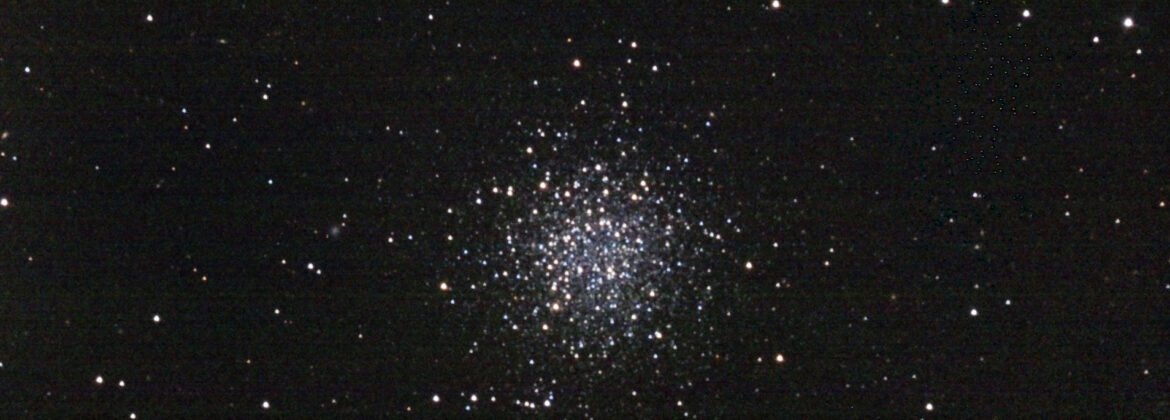NGC5466 is een XII klasse (erg dunbevolkte) “low surface brightness” bolvormige sterrenhoop in Bootes.
De sterrenhoop werd op 17 mei 1784 ontdekt door William Herschel en gaf het de indicatie H VI.9.
Het is een vrij ongebruikelijke bolvormige sterrenhoop omdat het Hertzsprung Russel diagram een bepaalde blauwe horizontale tak heeft.
Zo’n soort blauwe tak wordt ook wel HB (horizontal branch) genoemd. HB is een stadium van stellaire evolutie die direct volgt op het rode reuzen stadium in sterren waarvan de massa
overeenkomt met die van de Zon. HB sterren halen hun energie uit helium fusie in de kern en waterstof fusie in de schil die rondom de kern zit.
Door deze evolutiefase waarin wordt gestart met helium fusie ondergaan sterren substantiele veranderingen in hun stellaire structuur, dit resulteert in een vermindering van helderheid
en contractie, ook wordt het oppervlak helderder.
Wat ook uniek is aan deze bolvormige sterrenhoop, is dat ze ongebruikelijk weinig metallische sterren heeft, in vergelijking met andere bolvormige sterrenhopen.
Er wordt vermoedt, dat dit de oorzaak is van de zogenaamde “45 degree tidal stream” die werd ontdekt in 2006. Deze “stream is een ongeveer 1.4 graden brede sterrenlaan die zich uitstrekt
van Bootes tot Ursa Major.
Fysische gegevens:
Afstand: 51.800 lichtjaar
Magnitude: m10.5
Onderzoek:
Er is heel veel onderzoek verricht aan dit cluster. Zie voor de links deze pagina op wikipedia:
https://en.wikipedia.org/wiki/NGC_5466
Visueel waarnemen:
Burnhams Celestial Handbooks:
mag 9.0; diam 5′, class XII L, vRi, pC, stars mags 11
class for globular clusters, XII=very loose, sparse clusters
L=large vRi=very rich pC=pretty compressed
Sue French’s “Deepsky wonders” blz. 133, 134
NGC 5466 size 9′ magnitude 9.0 Millenium star atlas blz. 650 Uranometria 2000.0 kaart 70R
“Moving northward, we come to one of my favorite targets in Bootes, NGC5466, a ghostly globular star cluster with a low surface brightness.
Despite this, it can be glimpsed in a dark sky through binoculars.
Look for it 6 degrees west-southewst of Rho Bootis next to a 7th magnitude orange star.
Through a small telescope, NGC5466 is a weak, round glow about 5′ across.
My 105mm refractor at 87x can pick out only a few of the cluster’s brightest stars, but a 6- to 8-inch scope might catch a dozen.
Larger apertures will let you boost the magnification without making the cluster fade away.
With my 10-inch reflector at 213x, NGC5466 is 6′ across and very slightly elongated east-west.
More than two dozen faint to very faint stars shimmer over unresolved haze, the brightest strewn mostly around the edges.”
Ik heb ook nog op deepskylog gezocht naar waarnemingen en enkele mooie schetsen gevonden van diverse waarnemers:
Schets van Roel uit 2008 met 10″ Orion Optics Dobson: http://www.deepskylog.be/index.php?indexAction=detail_observation&observation=25393&QobsKey=4&dalm=D
Schets van TomC uit 2001 met 20cmF5 Helios newton: http://www.deepskylog.be/index.php?indexAction=detail_observation&observation=45356&QobsKey=2&dalm=D
Schets van Tom Borger uit 2011 met 41cm dobson: http://www.deepskylog.be/index.php?indexAction=detail_observation&observation=54696&QobsKey=1&dalm=D
Zo heel erg vaak is deze bolvormige sterrenhoop dus nog niet geschetst. De meest recente schets dateert uit 2016.
Opnamedatum: 19 april 2018
Telescoop: 200mmF5 ASH carbon Newton op astrosystems.nl montering
Camera: ZWO ASI174MM cooled (-25C)
Autoguiding: off axis met TSOAG9 met Lodestar SXV/PHD2.6
Corrector: ES HR (Harrie Rutten)
Filters: Baader 1.25″ R, G en B
Belichting: 16x120s R, 10x120s G en 9x120s B
Acquisitie: Nebulosity4
Pre-processing: AstroPixelProcessor
Post-processing: PixInsight & Photoshop CS6
Imagescale: 1.13″/pixel
Bedankt voor het kijken!
